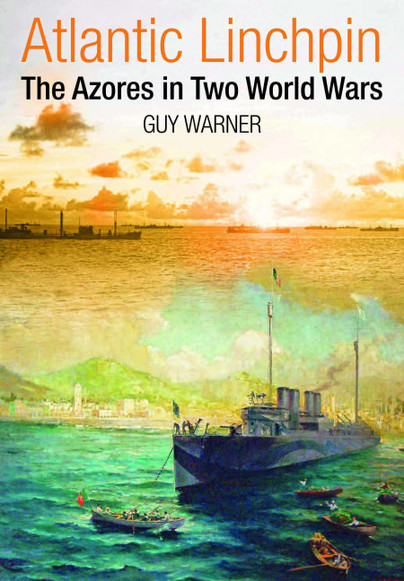Author Guest Post: Guy Warner
How I came to write about the Azores by Guy Warner
When I was at primary school in the 1960s, I often used to browse through my father’s copy of The Sheldon Book of Verse. I liked the poetry of Alfred, Lord Tennyson for its imagery and historical themes. I was particularly attracted to The Revenge A Ballad of the Fleet, which began,
‘At Flores in the Azores Sir Richard Grenville lay,
And a pinnance, like a fluttered bird, came flying from far away;
Spanish ships of war at sea! We have sighted fifty-three!’
I determined then and there that I would visit Flores one day, though it was not until 2004 that, with my wife, Lynda, I made the first of several visits to these nine diverse and unspoiled islands. On the walls of the lobby of our hotel in Horta (the Fayal Hotel) were a series of enlarged old photographs. I was immediately intrigued by these as they featured flying boats in the harbour and in particular the wonderful and iconic Boeing 314.
One result was a book, Under the Goshawk’s Wings- a History of Aviation in the Azores, first published in 2008, under the aegis of the Anglo-Portuguese Society. Another was the forging of many friendships with the hospitable people of the Azores and yet a third was developing an interest in Azorean history and its relationship to the Atlantic Ocean.
There are three distinct island groups spread over 400 miles (643km) of ocean. To the west are the tiny communities of Flores and Corvo. In the centre are grouped Faial, Pico, São Jorge, Graciosa and Terceira, while to the east are the islands of São Miguel and Santa Maria. Flores is 1100 miles (1770km) from Newfoundland and 2236 miles (3600km) from the East Coast of the United States of America, while from Santa Maria it is 869 miles (1400km) to Cabo da Roca in Portugal, the most westerly point of the European mainland.
Grenville had taken on the Spanish fleet off Flores in 1591 in order to save the rest of the small English squadron under Lord Thomas Howard, and died valiantly against enormous odds. Azoreans were resistant to Spain, which was the ruling power from late 16th century to mid 17th century. The harbours on the major islands had assumed a vital role in replenishing ships on their way back from the New World, Africa and the Orient on voyages of discovery, conquest and trade.
In the 1890s the first of several submarine cable stations was established on Faial, making the town of Horta into one of the major telegraphic communications relay centres of the world. In the 20th century control of the islands and of the surrounding seas was coveted by the opposing powers during both World Wars due to its pivotal position between the Old and New Worlds..
The genesis of this new account of the Azores’ part in the first world conflict of the 20th century stemmed from a conversation with António Sousa Monteiro of LPAZ, the Santa Maria Airport Historical Society. He asked me if I would like to produce a second, revised edition of Under the Goshawk’s Wings, translated by Paulo Alexandre da Silveira Noia Pereira and published in the Azores in November 2017. While I was carrying out research for this book, I uncovered more information that I could use about the naval and military aviation activities in the Azores in the First World War. I mentioned this to Professor Carlos Riley of the University of the Azores, who invited me to give a paper at a conference in the Azores on that conflict held at the University in November 2017:
‘COLÓQUIO INTERNACIONAL A GRANDE GUERRA E AS FRONTEIRAS DO ATLÂNTICO. As Ilhas no centenário do I conflito mundial/INTERNATIONAL CONFERENCE THE GREAT WAR AND THE ATLANTIC BORDERS. The Islands at the centenary of the first world conflict’
This paper has now been considerably expanded. The events I describe are, I believe, of seminal importance not only in Azorean history but also in US military/naval history.
Inter-alia these are:
(a) the first ever flight made in the Azores on 16th February 1918 by the USMC and the construction from scratch of an airbase
(b) the fact that the 1st Aviation Company USMC was the first formed US aviation unit to become operational in the Great War
(c) the Curtiss R-6, with which the Company was equipped, was the first US-built aircraft to perform an operational mission in the Great War
(d) the visit made to São Miguel by Assistant Secretary of the US Navy, Franklin D Roosevelt, in July 1918
(e) the humanitarian relief given by the USN and USMC in Ponta Delgada during the influenza epidemic of 1918
(f) the gallant fight against the odds of NRP Augusto de Castilho, defending the SS São Miguel from attack by U-139
(g) the pride felt by Azoreans in the contribution being made by Portugal in general and the Azores in particular to the global struggle.
At the very least it is worth considering what would have happened if the Germans had invaded the Azores in 1916 or 1917 and created a base there. My own feeling is that it would have been a much harsher regime than the partnership established with the Allies and also that a German naval base in the mid-Atlantic would have been a considerable thorn in the side of the US Navy and the Royal Navy.
Turning to the Second World War, in 2015 I was invited to the beautiful island of Santa Maria to take part in an international conference arranged by the Santa Maria Airport Historical Society, LPAZ. While I was there I had the pleasure of meeting Professor Carlos Guilherme Riley, the Head of the Department of History at the University of the Azores. He asked me if I would like to research and write the story of the Allied aviation effort in the Azores in the Second World War. The Azorean Institute of Culture very generously sponsored my research visit to the RAF Museum at Hendon and the UK National Archive at Kew. My extended article was subsequently published in Atlântida volume LXI 2016.
The Naval Staff History of the Second World War written by the Admiralty Historical Section notes that, ‘a most important strategic development’ took place in the autumn of 1943, ‘In the form of an agreement with the Portuguese Government of Dr António Salazar, after protracted negotiations, permitting the Allies to base aircraft at Lagens airfield on Terceira Island. This was to have a far-reaching effect on the safe passage of our Atlantic convoys, allowing more southerly routing under shore-based air cover and also bringing the United Kingdom to Gibraltar and West Africa convoys into this coverage now that they were routed farther to the westward clear of enemy aircraft range.’ Air Vice-Marshal Geoffrey Bromet would later write, ‘Operations both vast and momentous were being planned for the liberation of Europe and it was of great consequence to the Allies to extend the anti-U-boat net by having the use of bases in the Azores. Furthermore the establishment of a mid-Atlantic staging post to serve the ever-growing air transportation needs of the Allies was of great moment and urgency.’ This closure of the mid-Atlantic ‘air gap’, known to the U-boat crews as the ‘black pit’ was a vital contributory factor in winning the Battle of the Atlantic.
The geographical situation of the Azores made it of strategic interest to both sides in two World Wars. The remote and peaceful islands were drawn into the conflict and made a valuable contribution to winning the war against the U-boats of the Imperial German Navy and, a quarter of a century later, of the Nazi Kriegsmarine.
My new book, Atlantic Linchpin, ties together these different strands to tell the story in greater detail, and includes a considerable number of photographs.

Atlantic Linchpin is available to order here.

